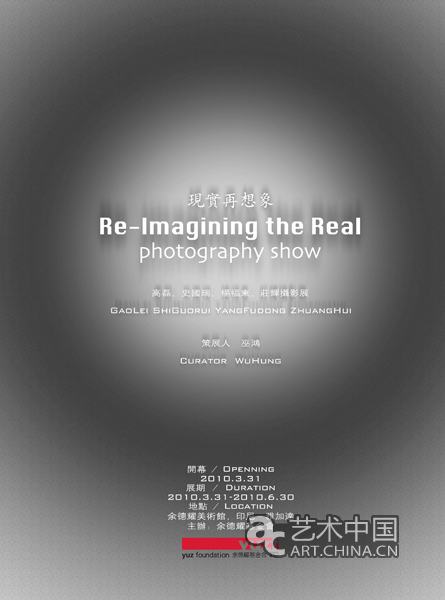
現實再想像——高磊、史國瑞、楊福東、莊輝攝影展
策展人:巫鴻
開幕時間:2010.3.31
展覽時間:2010.3.31—2010.6.30
展覽地點:余德耀美術館,印尼—雅加達
主辦單位:余德耀基金會
但甚至在觀念攝影最為流行的時刻,一些攝影家仍然堅持著攝影的基本性格。他們沒有以電腦代替相機,也沒有把對現實的解構作為再現的主要任務。這些攝影家中的佼佼者並不拒絕觀念的重要性。實際上,正是由於對觀念的濃厚興趣,他們進行了一系列技術和風格的實驗,力圖擴充紀實攝影的語言和範圍,達到觀念和寫實在一個新層次上的融合。值得注意的是,當數位攝影的影響在近年中開始減弱的時候,這種新型的“觀念化”紀實攝影則越來越顯示出它的生命力,開始産生一些重要的作品。其引人注目的一個原因是它反映出一種“攝影的回歸”(return of photography):人們在其中重新看到了對鏡頭和光線的使用,重新發現對相紙甚至膠片的敏感,以及攝影家對暗房技術的探索。但這又不是傳統意義上的紀實攝影,因為它們對技術的興趣往往和藝術家的觀念密切相關。在這個意義上,這些作品所代表的是一個雙重的逆反和綜合:在背離觀念攝影和傳統紀實攝影的同時對二者進行結構和綜合,以此建構自身的當代性(contemporaneity)。本次展覽中的四位藝術家可以説是這個潮流的代表。雖然他們的風格和技法各不相同,但是他們的靈感都因現實而發,他們的視覺語言都來自攝影的紀實性,但是他們的觀念又都反映了強烈而自覺的當代主體性。這些特點導致我把這次展覽標題為《現實再想像》---在中國攝影前沿上感觸和思考,他們以新的想像力重新接觸世界。
——摘自巫鴻《現實再想像》
Re-Imagining the Real -- Photography Show of Gao Lei, Shi Guorui, Yang Fudong, Zhuang Hui
Curator: Wu Hung
Opening: 2010.3.31
Duration: 2010.3.31—2010.6.30
Location: Yuz Museum, Indonesia-Jakarta
Organizer: Yuz Foundation
But even at the point when conceptual photography was at the height of its popularity, some photographers remained loyal upholders of the fundamental nature of the medium. They did not replace their cameras with computers and nor did they regard the deconstruction of reality as the main task of representation. The leading figures among this group of photographers were not rejecting the importance of concept. In fact, it was precisely because of a deep interest in concept that they carried out a series of experiments in technique and style, striving to expand the language and parameters of documentary photography so as to achieve an integration of concept and realism on a new level. It is worth noting that just as the influence of digital photography has begun to decline in recent years, this new type of ‘conceptualised’ documentary photography has more and more shown its vitality and has begun to produce a number of important works. One reason it has drawn attention is that it is a reflection of a kind of ‘return of photography’: people see in it afresh the use of lenses and light, discover anew a sensitivity to photographic paper and even film and to the explorations photographers make of darkroom technique. Yet nor is this documentary photography in the traditional sense, because the interest in technique is usually intimately interlinked with the artist’s conceptual thinking. In this sense these works represent a dualistic rebellion and integration: at the same time as conceptual photography and traditional documentary photography are rejected, the two are reconstructed and synthesised and so their own contemporaneity is made. The four artists brought together in this exhibition can be said to be representatives of this current. Although they differ in style and technique, they all take reality as progenitor of their inspiration; all of them employ a visual language coming out of the documentary nature of photography; but the concepts in their work are also a reflection of a powerful and self-conscious contemporary subjectivity. It has been these particular features that lead us to title this exhibition Re-imagining the Real – thinking and feeling at the very forefront of Chinese photography, they are using a new imagination to make a fresh engagement with the world.
——Excerpt from Re-imagining the Real by Wu Hung